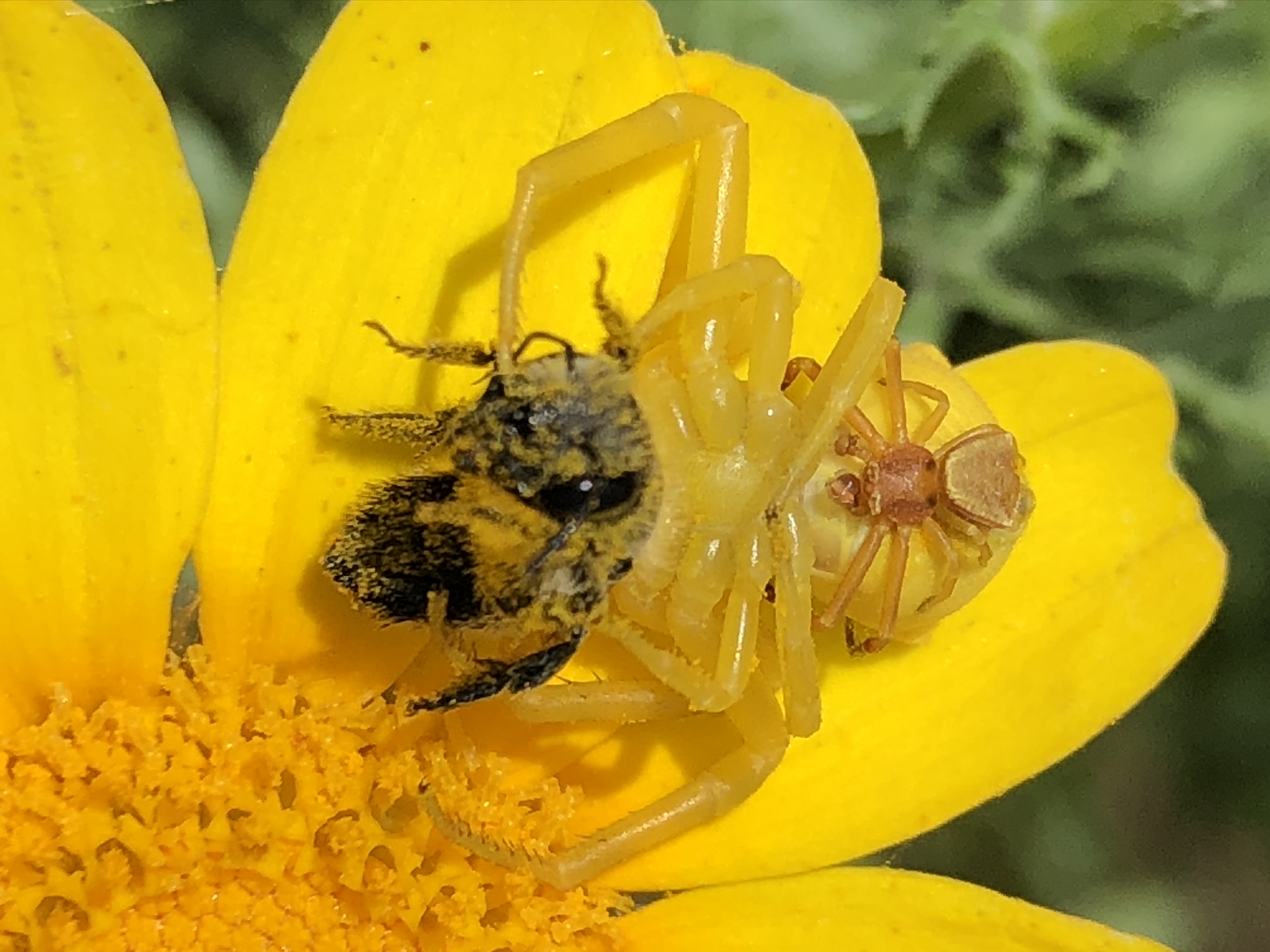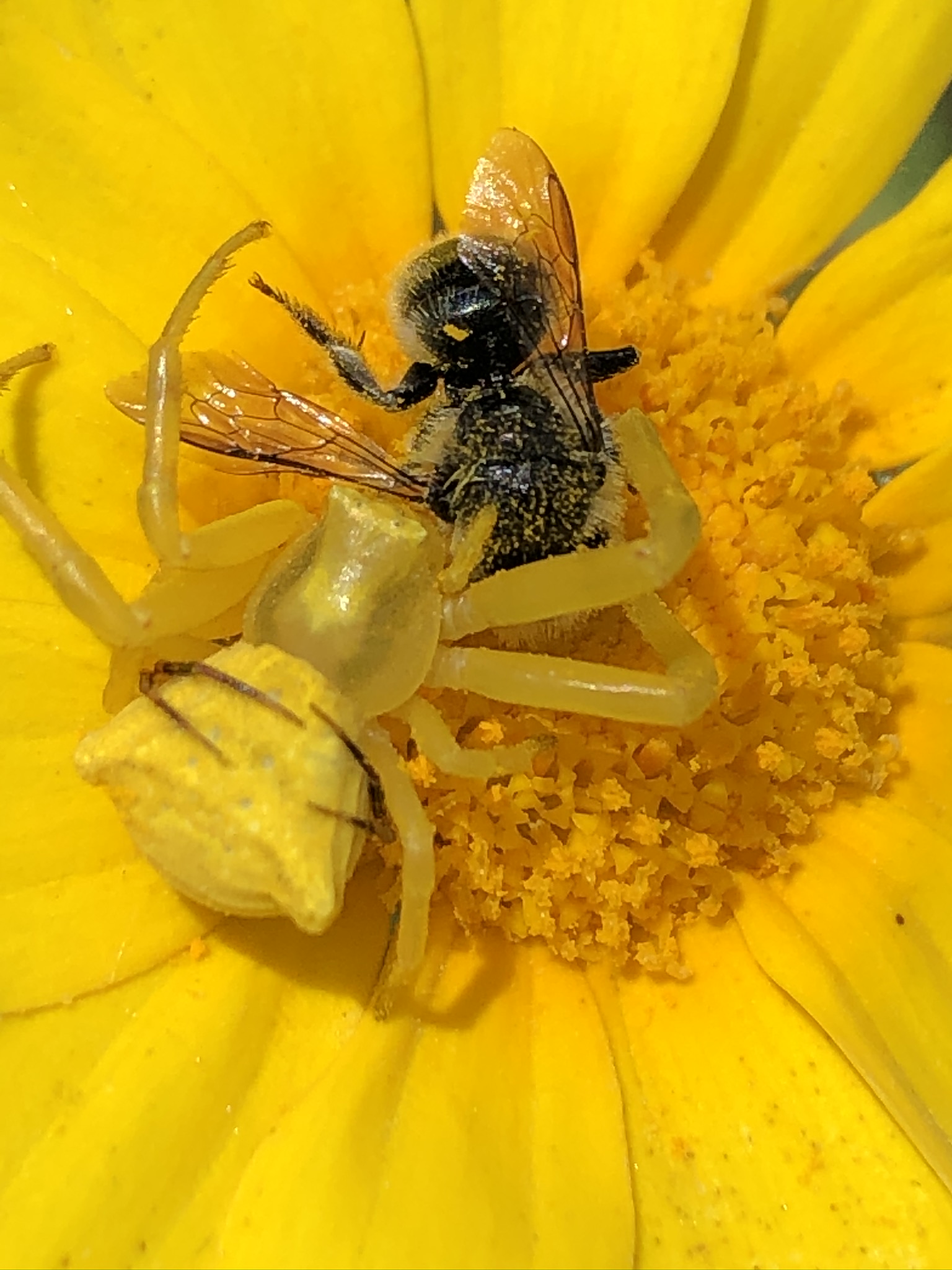I was out for a short time and was passing through my every day passage, leading to my home, when I noticed something strange on a yellow daisy.
A creepy creature had its legs around a still bee .. that poor thing was probably dead. Luckily, curiosity overcame my initial fear so I went closer.

What I was seeing was a spider, being upside down, holding a bee and another smaller spider was attached to the big spider's head. Strange? I went closer, tried to took a few shots and a short video..

Then, I tried to turn it upside down. It was surely scared but I am sure it was not hurt at all (see below why)
When I came back home I wondered what kind of spider it was. Searching for a "yellow spider eating bees", I came up with a few useful information - and I am happy to share them with you!
Crab spiders are ambush predators rather than web-spinners, and bees can often be their unsuspecting victimssource

Name: Goldenrod crab spider or flower (crab) spider (officially Misumena Vatia)
Misumena Vatia is a type of crab spiders, which takes its name of a specific flower they are found hunting on Solidago or Goldenrog.
Geographical Location
This species is mostly encountered in North America, but is also found in South America and also in Europe.
Appearance
As the name crab spider suggests, this spider resembles a crab - as its body is short and its legs are larger and long. The females are almost double the size of the males (6-9mm).
One of the things that makes them special is their ability to adapt according to the enviroment. They could be found as yellow or white ones, depending on the color of the flower they are on. (I found my spider on a yellow daisy, and its color was bright yellow). This ability is called active camouflage and crab spider is one of the few species that can do it.
As Mr Gary Dodson, a biologist at Ball State University stated , this is one of the few species thta can reversibly change their body color, in a match to the flowers on which they ambush their pray. He continued saying that females, but not fmales can switch between white and yellow depending on the background.
Change of Color
As per wikipedia, "They change color by secreting a liquid yellow pigment into the outer cell layer of the body.". For the white color, this pigment goes into lower layers, and this causes their inner glands to become visible.
This is not an instant action, for a change from white to yello, it can take up to 10 and more days, however the reverse action takes about 6 days.
Do they bite?
The crab spiders feed on intertebrates, it bites them with its fangs and they die as a result of its venom. However the venom cannot help agains larger animals. It feeds on flies, grasshoppers, bees etc.
How do they hunt?
The crab spider hides on a flower, and ambushes insects that land there. They usually are not spotted due to their camouflage. When the insect sits on the flower, the crab spider catches it and kills it.
Are they dangerous?
They are not dangerous to humans, only to their preys. Their venom is too weak for us grown ups :)
I went to check on the spider again after approximately 20 minutes and I saw that it was trying to hide from me - escaping slowly.

What about .. web?
This species does not use a web to hunt, it lurks and attacks - and it is often characterized as a .. hunter.
Are pollination rates affected?
I wondered if they are dangerous for pollination, so I searched it up. In this article it is mentioned that even though they are also feeding on bees (beneficial pollinators of nature), but they also feed on pests and other species. Additionally, they are prey for lizards, birds etc and this all creates a balance in the garden environments.
They are certainly beautiful to watch, and beyond possibly snacking on an occasional bee, they are great little garden helpers.
Thank you for visiting!
Sources and further reading:
https://usaspiders.com/misumena-vatia-flower-crab-spider/
https://www.theguardian.com/environment/2018/jul/20/country-diary-when-a-crab-spider-executes-plan-bee
https://en.wikipedia.org/wiki/Misumena_vatia
https://plantersplace.com/pest-patrol/do-crab-spiders-really-eat-bees/
https://animaldiversity.org/accounts/Misumena_vatia/
https://www.natureworldnews.com/articles/14073/20150414/camouflaged-spider-change-color.htm
My personal discoveries and every day experiences: https://www.instagram.com/katycrete/
My city's account and lovely community: https://www.instagram.com/aboutheraklion/
And let's not forget my giphy channels
For my city: https://giphy.com/channel/aboutheraklion
My personal account: https://giphy.com/channel/katyramm
Thank you for visiting!
Original Content and images

spider feeding on bees! interesting. I never imagined that :o
Thanks for your contribution to the STEMsocial community. Feel free to join us on discord to get to know the rest of us!
Please consider supporting our funding proposal, approving our witness (@stem.witness) or delegating to the @steemstem account (for some ROI).
Please consider using the STEMsocial app app and including @stemsocial as a beneficiary to get a stronger support.